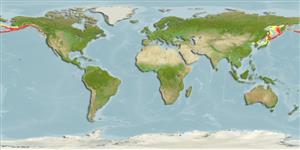Environment: milieu / climate zone / depth range / distribution range
Ecologia
marino batidemersale; distribuzione batimetrica 25 - 925 m (Ref. 6793), usually 100 - 380 m. Deep-water; 61°N - 37°N
North Pacific: Sea of Japan to the Bering Sea and southeastern Alaska.
Size / Peso / Age
Maturity: Lm ? range ? - ? cm
Max length : 26.0 cm TL maschio/sesso non determinato; (Ref. 7297); 30.8 cm SL (female); common length : 16.0 cm TL maschio/sesso non determinato; (Ref. 2850); Età massima riportata: 8 anni (Ref. 122394)
Short description
Chiavi di identificazione | Morfologia | Morfometria
Spine dorsali (totale) : 10 - 12; Raggi dorsali molli (totale) : 21 - 23; Spine anali: 0; Raggi anali molli: 20 - 24. Eye large, orbital diameter 1.5 times snout length; maxillary with small ctenoid scales (Ref. 559).
Commonly between 100 and 380 m on mud, sand, pebbles, gravel and shell.
Life cycle and mating behavior
Maturità | Riproduzione | Deposizione | Uova | Fecundity | Larve
Pietsch, T.W., 1993. Systematics and distribution of cottid fishes of the genus Triglops Reinhardt (Teleostei: Scorpaeniformes). Zool. J. Linn. Soc. 109:335-393. (Ref. 7297)
IUCN Red List Status (Ref. 130435: Version 2024-1)
Threat to humans
Harmless
Human uses
Pesca: di nessun interesse
Strumenti
Special reports
Download XML
Fonti Internet
Estimates based on models
Preferred temperature (Ref.
123201): 0.9 - 5.9, mean 3.7 °C (based on 238 cells).
Phylogenetic diversity index (Ref.
82804): PD
50 = 0.5010 [Uniqueness, from 0.5 = low to 2.0 = high].
Bayesian length-weight: a=0.00589 (0.00349 - 0.00994), b=3.20 (3.05 - 3.35), in cm total length, based on LWR estimates for this species & (Sub)family-body (Ref.
93245).
Trophic level (Ref.
69278): 3.2 ±0.3 se; based on diet studies.
Generation time: 10.0 ( na - na) years. Estimated as median ln(3)/K based on 1
growth studies.
Resilienza (Ref.
120179): Molto basso, tempo minimo di raddoppiamento della popolazione più di 14 anni (Preliminary K or Fecundity.).
Fishing Vulnerability (Ref.
59153): High vulnerability (61 of 100).
